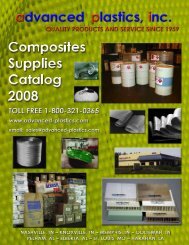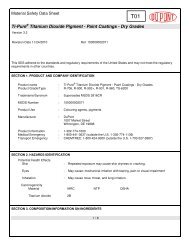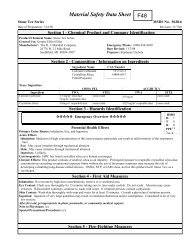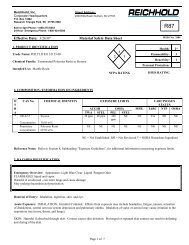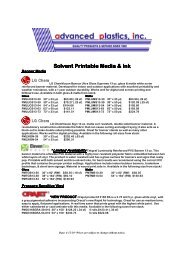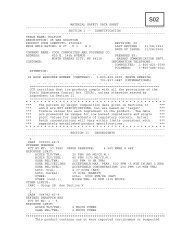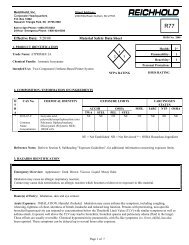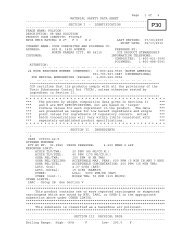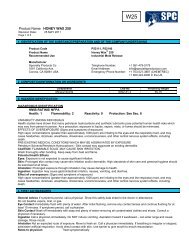Material Safety Data Sheet R87 - Advanced Plastics
Material Safety Data Sheet R87 - Advanced Plastics
Material Safety Data Sheet R87 - Advanced Plastics
You also want an ePaper? Increase the reach of your titles
YUMPU automatically turns print PDFs into web optimized ePapers that Google loves.
POLYLITE® 32154-25<br />
Revision Date: 06 Feb 2012<br />
__________________________________________________________________________________________<br />
8. EXPOSURE CONTROLS / PERSONAL PROTECTION<br />
Canada - Alberta OELs<br />
100 ppm STEL<br />
483 mg/m 3 STEL<br />
50 ppm TWA<br />
242 mg/m 3 TWA<br />
Canada - Ontario OELs<br />
50 ppm TWA<br />
100 ppm STEL<br />
Canada - British Columbia OELs<br />
50 ppm TWA<br />
75 ppm STEL<br />
100 ppm Ceiling<br />
NIOSH IDLH 700 ppm Immediately dangerous to life or health (IDLH)<br />
Mexico OEL<br />
100 ppm STEL<br />
485 mg/m 3 STEL<br />
50 ppm TWA<br />
240 mg/m 3 TWA<br />
Legend<br />
ACGIH - American Conference of Industrial Hygienists<br />
TLV - Threshold Limit Value<br />
TWA - Time weighted average<br />
STEL - Short Term Exposure Limit<br />
OSHA - Occupational <strong>Safety</strong> and Health Administration<br />
PEL - Permissible Exposure Limit<br />
OEL - Occupational Exposure Limit<br />
NIOSH - National Institute for Occupational <strong>Safety</strong> and Health<br />
IDLH - Immediately Dangerous to Life or Health<br />
SKIN: Skin Absorption<br />
Engineering Controls:<br />
Personal Protective Equipment<br />
Eye/face Protection:<br />
Skin Protection:<br />
Respiratory Protection:<br />
Use general ventilation to maintain airborne concentrations to levels that are below regulatory<br />
and recommended occupational exposure limits. Local ventilation may be required during<br />
certain operations. Use explosion-proof equipment.<br />
<strong>Safety</strong> glasses with side-shields. If splashes are likely to occur, wear:. Tightly fitting safety<br />
goggles. Ensure that eyewash stations and safety showers are close to the workstation<br />
location.<br />
Wear chemical-resistant gloves such as polyvinyl alcohol or Viton. Gloves made of nitrile<br />
rubber or polyvinyl chloride (PVC) may be used for splash protection and brief or intermittent<br />
contact with styrenated polyester resin. Please observe the instructions regarding permeability<br />
and breakthrough time which are provided by the supplier of the gloves. Also take into<br />
consideration the specific local conditions under which the product is used, such as the danger<br />
of cuts, abrasion. Impervious clothing. Rubber or plastic boots.<br />
None required if hazards have been assessed and airborne concentrations are maintained<br />
below the exposure limits listed in Section 8. Wear an approved air-purifying respirator with<br />
organic vapor cartridges and particulate filters where airborne concentrations may exceed<br />
exposure limits in Section 8 and/or there is exposure to dust or mists due to sanding, grinding,<br />
cutting, or spraying. Use an approved positive-pressure air-supplied respirator with emergency<br />
escape provisions if there is any potential for an uncontrolled release, airborne concentrations<br />
are not known, or any other circumstances where air-purifying respirators may not provide<br />
adequate protection.<br />
9. PHYSICAL AND CHEMICAL PROPERTIES<br />
Appearance:<br />
Greenish-blue - Clear<br />
Odor:<br />
Pungent<br />
Odor Threshold:<br />
0.2 ppm (Styrene)<br />
Physical State:<br />
Liquid<br />
pH:<br />
Not applicable<br />
Flash Point: 32°C / 89°F<br />
Flash Point Method:<br />
Seta closed cup<br />
__________________________________________________________________________________________<br />
Page 4 / 9





